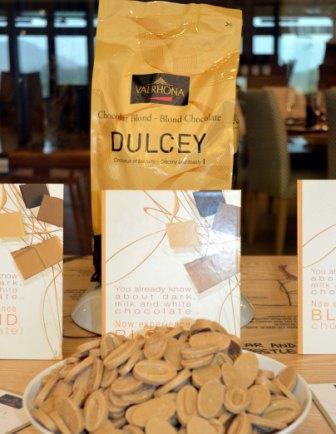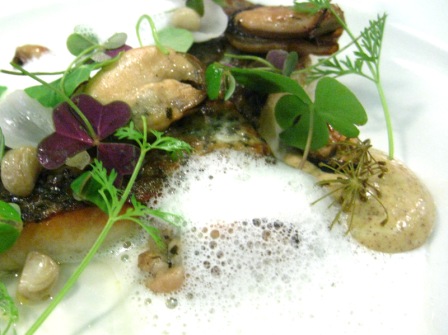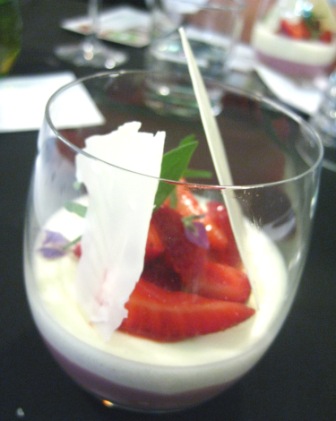Pear and chocolate studded gingerbread
Posted: April 30, 2013 Filed under: Recipes | Tags: Baking, Chocolate, Recipe, Valrhona, Wild Peacock 1 CommentFeaturing 32 % Valrhona Dulcey Blond chocolate
For a reason I struggle to put my thumb on, gingerbread has always had a nostalgic childhood motif attached to it. I think it’s because I have memories of my Grandmother baking tooth-breakingly crunchy ginger biscuits (that unfortunately could only be softened once dunked in a cup of her instant Ricoffy. Bless her heart.)
Or… it could be that I was brought up with bulging bookcases of classic children’s literaure and Nursery Rhymes. Remember Hansel and Gretel? Or how about, “Run, run, run as fast as you can; You can’t catch me, I’m the Gingerbread Man“?
Whatever the explanation, it’s always nice to be transported – if only by the vehicle of food, to those carefree, fairy-tale filled years. Sometimes life can be overwhelming and strange. Very strange. But chocolate cupcakes, Rice Crispie marshmallow bars and gingerbread will always be a stir of a wooden spoon away.
This recipe isn’t a traditional gingerbread, mainly because it has the addition of pears and chocolate (what!). I was given a sample of the recently launched Valrhona 32% Dulcey Blond chocolate by the generous folks at Wild Peacock and thought my gingerbread crusade was a perfect opportunity to put it to good use. Interestingly and, like most notable dishes in the food world, it was actually created by accident when a French pastry chef left white chocolate in a bain marie for 10 hours. Thus, giving it a rich, toasted shortbread, caramel butterscotch character.
All I can say is, the flavour profile worked wonders with the pear and ginger. Try it!
Pear and chocolate studded gingerbread
2 cups flour – sieved
1/3 cup honey
1 Tbs molasses
1.5 Tbs ground ginger
1/2 tsp nutmeg
1 tsp cinnamon
2 tsp baking powder
1 tsp baking soda
1/4 teaspoon salt
2 pears – chopped
3/4 cup chopped Valrhona Dulcey chocolate (or any chocolate of your choice)
1/4 cup coconut oil
2 large eggs – beaten
Method:
Preheat to 180°C. Grease a standard -size loaf tin. Sieve the flour, ginger, cinnamon, nutmeg, baking powder, baking soda and salt into a large mixing bowl.
Whisk together the honey, molasses, coconut oil and eggs.Add the buttermilk
Stir the mixture slowly into the dry ingredients and combine to form a stiff but moist batter. Gently fold in the chocolate and pears.
Spoon the batter into the prepared loaf tin and bake in the middle of the oven for 40 – 45 mins. If the top starts to burn, cover with a piece of tinfoil until cooked all the way through. Test by inserting a skewer. It should come out clean.
Serve warm with salted butter or just on it’s own.
Sustainable Seafood with Wild Peacock and Oceanwise
Posted: October 24, 2011 Filed under: Rambles, Restaurants, Reviews, Uncategorized | Tags: Aquaculture, Dear Me, Eric Bulpitt, Fish Farming, Kabeljou, Oceanwise, SASSI, Sustainable Seafood, The Food Emporium, The Roundhouse, Valrhona, Vanessa Marx, Vanessa Quellec, Wild Peacock 3 CommentsMy first introduction to SASSI (South African Sustainable Seafood Initiative) came about five years ago when I was at ICA. During that stage, it was still fairly new and most people weren’t very aware of what it actually stood for. Little booklets then became available for people to check out what fish was on what list and whether or not their favourite restaurants were serving seafood on the ill-fated “red list”.
I’d say nowadays the awareness of eating sustainably is slowing gaining consciousness in the food industry-with a few restaurants leading the way in terms of educating their customers, while at the same time encouraging fellow establishments to become SASSI registered. Dear Me Foodworld in Cape Town’s Longmarket Street is one that has been classified as a SASSI “champion status” restaurant meaning they only serve seafood off the green list. Nowhere will you find prawns or even Kingklip on their menu. Another seafood eatery, The Brass Bell in Kalk Bay, has very cleverly printed SASSI-marked symbols next to each dish on the menu- which just shows the effort that they’re making to create awareness in the minds of their customers.
Obviously for a restaurant to take something like this seriously, a lot has to depend on suppliers. Wild Peacock and Ocean Jewels (both in the Western Cape) are two that deserve a good mention. I was privileged enough last week to be able to spend some time with the effervescent Julie from Ocean Jewels, as well as the team from Wild Peacock, at a dinner held in their beautiful Food Emporium in Stellenbosch. Wild Peacock is a supplier of sustainably farmed kabeljou which they source from OceanWise, a sustainable fish farm in East London, Eastern Cape. Go EC! My home province! (yeah, and all you thought we had was Oxbraai!!) . They are supported by Dear Me and The Roundhouse in Camps Bay (among others).
The evening was amazing with a 3 course dinner consisting of dishes prepared by Dear Me’s head chef Vanessa Marx, Eric Bulpitt from The Roundhouse and Miss Valrhona (aka talented pastry chef, Vanessa Quellec). The marketing guys from Oceanwise were there as well which made for a really worthwhile and informative evening. They had a small presentation with slides of what the fish farm actually looked like. Rather fascinating! All three of them were fantastic and were able to answer all of our questions while we gnawed away on their ethically farmed produce.
Wild Peacock have been supplying South Africa’s restaurant industry for over two decades with nothing but the best-quality ingredients and service, which makes them the ideal distributors of the sustainably farmed Kabeljou. They are however most well-known for their Saldanha Bay oysters which you’ll always find being offered to the public at prominent wine and food festivals:)
The Wild Peacock family really make the brand what it is- Sue together her son Ross run an amazing business, with daughter Sarah managing the Food Emporium.
Contact
Follow them on twitter: @WildPeacock, @SueBakerFood, @Food_Emporium
Or go to their website and check out the amazing products!
For information on Oceanwise, get hold of Liam Ryan: 082 771 9507
email: liam@espadonmarine.co.za
Did You Know?
– Kabeljou is also known as Dusky Kob
– The Australians call the fish `Mulloway’
– it takes 12 to 15 months for the fish to reach 1.5kg in weight
– The spawning cycle is managed by temperature and light control
– In South Africa wild Kob has to be 40cm by law.
– Oceanwise fish are over 40cm
– The Kob reach sexual maturity at approx 10kg and 10 years old
– 10 million eggs are produced per spawning female (usually spawn one female at a time)
– They only have a 50% hatchery rate
– Guy and Maryke Musson together with a small dedicated team from Oceanwise pioneered kabeljou farming in South Africa
– 10% of the water that is circulated and treated goes back into the ocean
xxx








